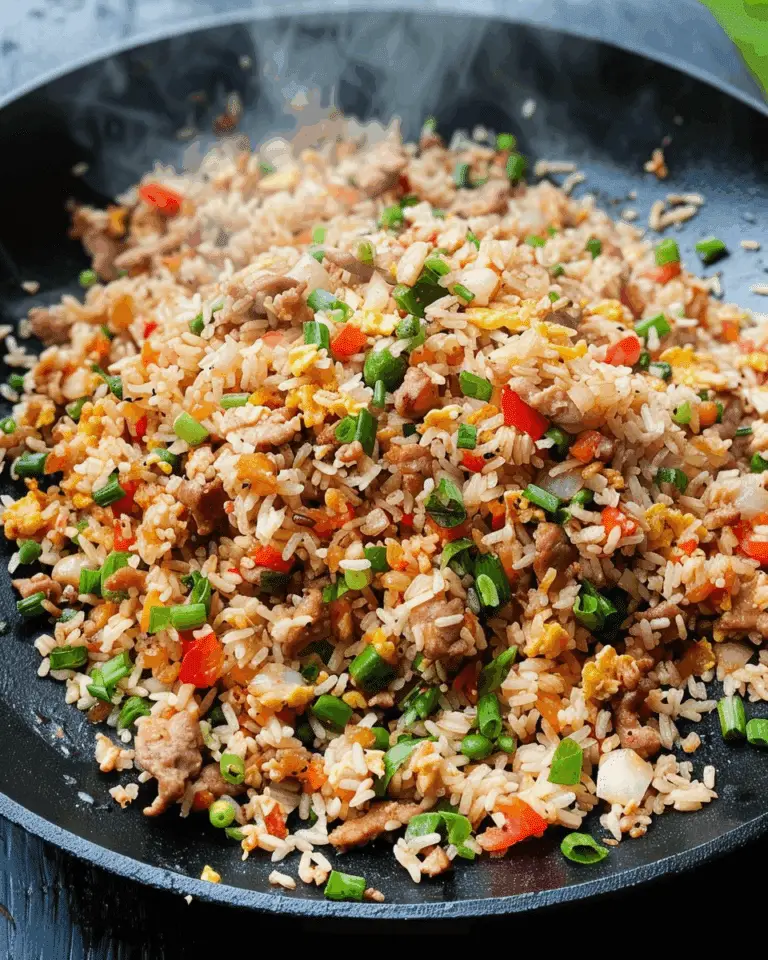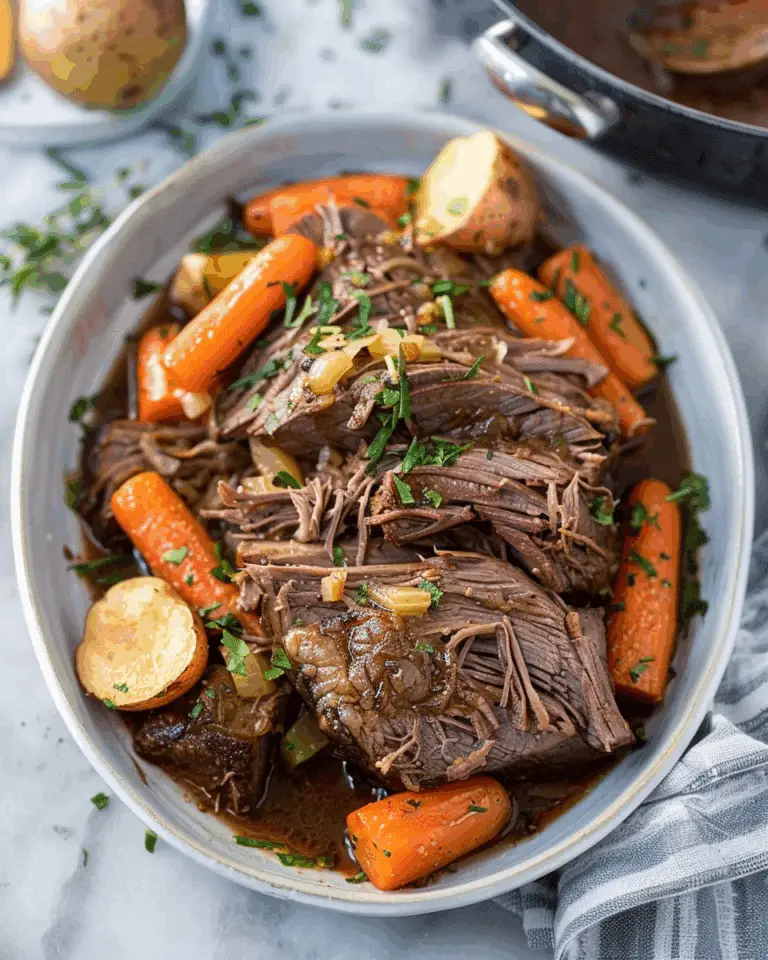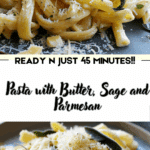Why You’ll Love Pasta with Butter, Sage and Parmesan Recipe
-
It comes together very quickly and easily, making it ideal for a weeknight dinner when you want something satisfying without hours in the kitchen.
-
The browned butter adds nutty, caramel‑like depth, while the fresh sage contributes a fragrant herbal note that elevates the dish.
-
Parmesan brings salty umami richness and ties the flavors together beautifully.
-
Despite the gourmet taste, only minimal special ingredients are required—great when you want something special but simple.
-
It’s versatile and forgiving: you can substitute similar herbs or pasta shapes, adjust the butter or cheese, and it still works.
Ingredients
(Tip: You’ll find the full list of ingredients and measurements in the recipe card below.)
-
Pasta (such as linguine, spaghetti, or your preferred shape)
-
Unsalted butter
-
Fresh sage leaves
-
Freshly grated Parmesan cheese
-
Salt and freshly ground black pepper
-
Optional: a couple of tablespoons of reserved pasta cooking water
Directions
-
Bring a large pot of well‑salted water to a boil. Add the pasta and cook according to package instructions until al dente.
-
While the pasta is cooking, melt the butter in a small saucepan or skillet over moderate heat. Add the sage leaves and season lightly with salt and pepper. Continue cooking until the butter turns a light golden‑brown (browned butter), and the sage leaves become fragrant and slightly crisp.
-
Before draining the pasta, scoop out 2–3 tablespoons of the starchy pasta cooking water and set aside.
-
Drain the pasta, then immediately transfer it to a large warm bowl. Pour over the browned butter and sage mixture. If needed, add a splash of the reserved pasta water to help loosen and coat the pasta. Add about half of the Parmesan cheese, then toss everything together until the pasta is well‑coated and the sauce clings nicely.
-
Taste and adjust seasoning with more salt and pepper as needed. Serve the pasta topped with the remaining Parmesan cheese, and if you like, garnish with extra crisp sage leaves.
Servings and timing
Makes about 4 servings.
Total time: approximately 15–20 minutes (about 5 minutes prep, 10 minutes cooking).
(If your pasta shape or package suggests different timing, adjust accordingly.)
Variations
-
Use fennel‑cut pasta (bronze‑cut) or a pasta shape with texture (e.g., rigatoni, pappardelle) for more sauce cling.
-
Substitute the fresh sage with thyme, parsley, or chervil for a different herbal note.
-
Add toasted breadcrumbs or chopped toasted nuts (e.g., walnuts or pine nuts) for extra texture.
-
Include a splash of lemon juice or lemon zest to brighten the dish.
-
Stir in some steamed or sautéed vegetables (like zucchini ribbons or peas) for added colour and nutrition.
-
For a richer version, add a few tablespoons of heavy cream or partial cream and stir gently until warm and combined.
Storage/Reheating
-
Store leftovers in an airtight container in the refrigerator for up to 2 days.
-
When reheating, add a splash of pasta cooking water or milk/cream to help loosen the sauce and prevent it from drying out. Reheat gently over low heat or in the microwave, stirring occasionally.
-
Because the butter and cheese may firm up when cold, reheating carefully helps restore the silky texture.
-
Note: Fresh sage leaves will lose crispness over time—if you plan to store, reserve extra for fresh garnish upon serving.
FAQs
How can I avoid the butter from burning?
Melt the butter over medium‑low heat and watch it carefully. Once the milk solids begin to brown and you see a light golden‑brown colour, remove it from direct heat. The moment the butter smells nutty and has golden bits, it’s ready. Timing is key.
Can I use dried sage instead of fresh?
Yes, but the flavour and texture will differ. Use a smaller amount of dried sage (since it’s more concentrated) and add it earlier so it has time to infuse the butter. Fresh sage leaves lend a brighter flavour and become crisp in the butter, which adds texture.
What type of pasta works best for this dish?
Any good quality dried or fresh pasta will work, but shapes with more surface area or texture (such as linguine, fettuccine, rigatoni, or bronze‑cut varieties) help the sauce cling better.
Is freshly grated Parmesan important?
Yes—it makes a noticeable difference. Freshly grated Parmesan melts more smoothly into the sauce and has better flavour than pre‑grated or powdered cheese.
Can I make this dish ahead of time?
You can cook the pasta slightly under al dente, cool it, and store it separately from the sauce components. When ready to serve, reheat the butter‑sage sauce, add the pasta, toss with Parmesan and a bit of pasta water, and serve immediately. However, the texture is best when freshly combined.
What if I don’t have pasta cooking water reserved?
You can substitute a little hot water, or even a light broth, but pasta cooking water is ideal because the starch helps emulsify the sauce and ensure it clings to the pasta well.
Can I make it vegetarian or vegan?
Vegetarian: yes—this recipe is already vegetarian if you ensure the Parmesan is made without animal rennet. Vegan: substitute the butter with a plant‑based butter, and use a vegan hard cheese or nutritional yeast. The result will differ in flavour but still be tasty.
How do I reheat leftovers without drying out the sauce?
Reheat gently over low heat with a splash of hot water, milk, or cream, stirring frequently so the sauce loosens and coats the pasta again. Avoid high heat which can curdle or separate the butter/cheese mixture.
Can I add protein or other ingredients to make it more substantial?
Absolutely. You could add cooked chicken breast, sautéed shrimp, browned sausage, roasted vegetables, or sautéed mushrooms. Add the extra ingredients at the toss‑stage so they are warmed through and incorporated.
Why did my sauce become watery?
If you added too much pasta water (or other liquid) relative to the butter and cheese, the sauce can become loose. If that happens, continue cooking gently and stirring so the mixture reduces slightly and the cheese emulsifies into the sauce. Adjust by adding a little more Parmesan to thicken.
Conclusion
This Pasta with Butter, Sage and Parmesan is a beautifully simple dish that proves how a few quality ingredients and good technique can yield something special. It’s quick to make, full of flavour, and flexible enough to adapt to your pantry or mood. Whether for a relaxed weeknight meal or an elegant dinner, this recipe delivers comfort and sophistication in equal measure.

Pasta with Butter, Sage and Parmesan
- Total Time: 20 minutes
- Yield: 4 servings
- Diet: Vegetarian
Description
A simple yet flavorful Italian pasta dish made with butter, fresh sage, and Parmesan cheese. It’s a comforting and elegant meal that comes together quickly.
Ingredients
- Salt
- 1 pound pasta (such as fettuccine or tagliatelle)
- 4 tablespoons unsalted butter
- 15 to 20 fresh sage leaves
- ¾ cup freshly grated Parmesan cheese, plus more for serving
- Freshly ground black pepper
Instructions
- Bring a large pot of salted water to a boil. Add pasta and cook until al dente according to package directions.
- While the pasta cooks, melt the butter in a large skillet over medium heat.
- Add the sage leaves and cook until the butter just begins to brown and the sage is crisp, about 3 to 5 minutes. Remove from heat.
- Drain the pasta, reserving about ½ cup of the pasta cooking water.
- Add the drained pasta to the skillet with the butter and sage. Toss to coat.
- Add the Parmesan and a bit of the reserved pasta water to loosen the sauce as needed. Toss until creamy and well combined.
- Season with salt and freshly ground black pepper to taste.
- Serve immediately with extra Parmesan on top.
Notes
- Use high-quality butter and cheese for best flavor.
- Do not overcook the sage; it should be crisp but not burnt.
- Great as a main dish or a side for grilled meats or vegetables.
- Prep Time: 5 minutes
- Cook Time: 15 minutes
- Category: Dinner
- Method: Stovetop
- Cuisine: Italian
Nutrition
- Serving Size: 1/4 of recipe
- Calories: 520
- Sugar: 2g
- Sodium: 420mg
- Fat: 22g
- Saturated Fat: 13g
- Unsaturated Fat: 8g
- Trans Fat: 0g
- Carbohydrates: 64g
- Fiber: 3g
- Protein: 17g
- Cholesterol: 55mg








